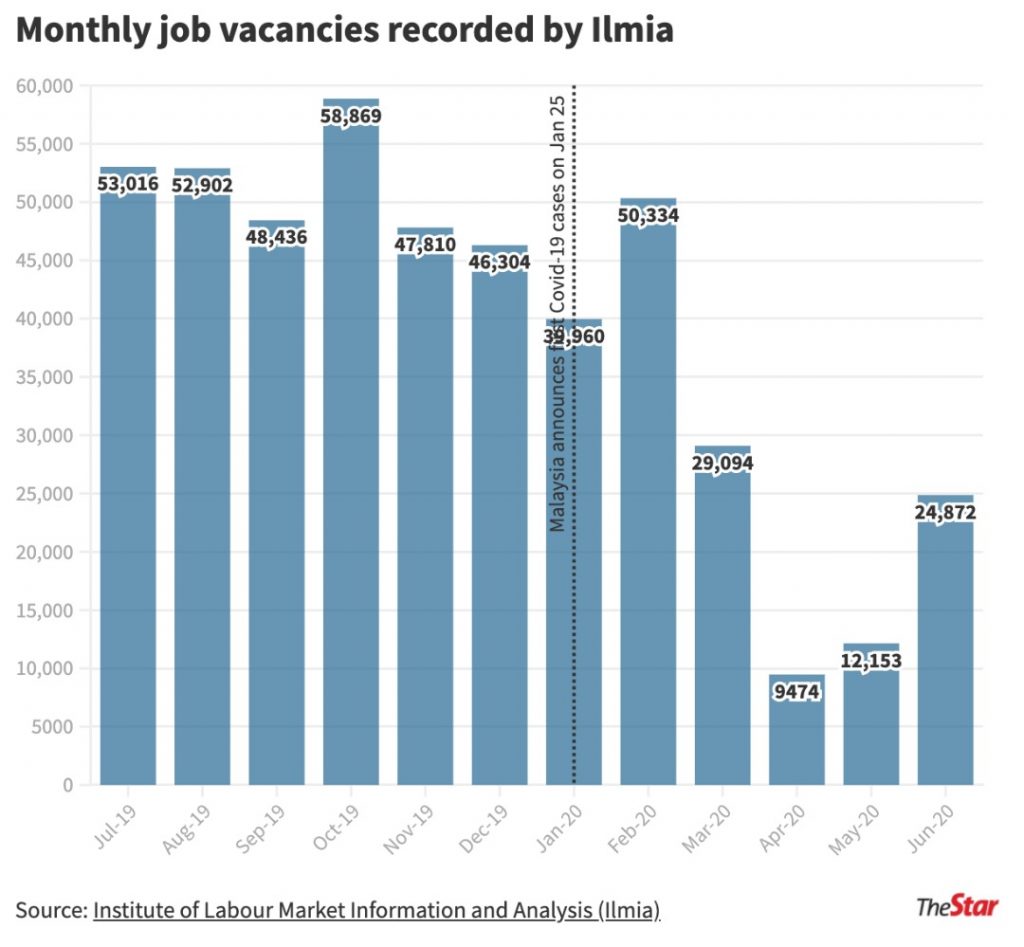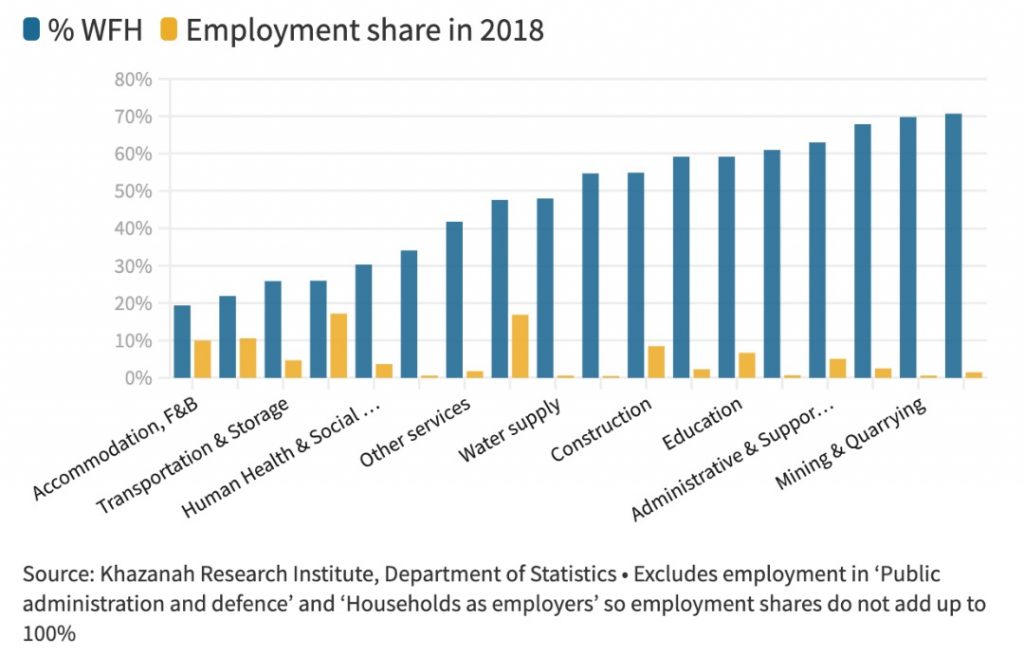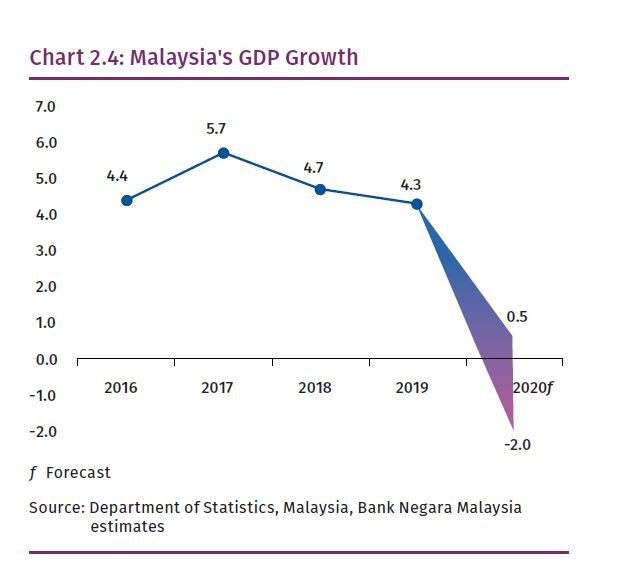By Reem Ahmed and Fahd Atolis
The COVID-19 pandemic has plunged many countries into an economic crisis. While the virus was slowly starting to spread, it didn’t take long for economists to prepare for the worst.
Like any other country, Malaysia has been suffering economically including the challenges of unemployment suffered by the people following the outbreak.
The COVID-19 pandemic has evolved into health, socio-economic and humanitarian crisis of unprecedented scale and impact. At this crucial time, Malaysia is exasperated by the fact that the new government only came to power in early March 2020, while the country was already facing a heavy debt problem, financial restrictions, falling oil prices, and spillover effects on trade and tourism caused by the global lockdown.
The number of Malaysian unemployed individuals has been increasing since the first announcement of COVID-19 cases in Malaysia (25 January 2020) starting from 511,700 and reaching its highest at 826,100 in May, before declining to 737,500 in September.
Job vacancies in Malaysia show a huge drop starting from 50,334 in February to the lowest record of 9,474 in April before rebounding to 24,872 in June, according to a report by Ilmia (the Institute of Labour Market Information and Analysis). The report also highlighted the job roles which have the biggest numbers of vacancies such as plant and machine operators having the highest number with 11,428 vacancies, financial and investment advisors as to the second top with 5,111 openings, and advertising and marketing professionals as the third place with 2,864 job openings.


The plant and machine operators include positions such as production operators, machine operators, line leaders, equipment and machine operators, and heavy machine operators. While financial and investment advisors involved jobs like sales executives, marketing executives, business development executives, digital marketing executives, and social media marketing executives.
What does the job scope look like during the pandemic period?
According to recruitment agency Jobstreet, working from home could now be the common theme of many Malaysian businesses during the COVID-19 pandemic. While in fact, the new norm may not be suitable for many workers especially those who are self-employed or categorised as vulnerable, Khazanah Research Institute reported.
Moreover, Jobstreet also recorded that the top five industries requiring their employees to work from home are insurance or pension funding (81%), followed by information technology (77%), education (70%), property development (70%), and banking (69%).
It also highlighted that home workers are more often found in huge organisations with more than 5,000 employees, where those workers are likely to be females between the age of 30-39, workers with higher salaries, and most commonly located in Kuala Lumpur or Selangor.
Therefore, high incomes, long-term and full-time employees are most likely to be interested to work from home, noted Jobstreet. This was also agreed by Siti Aisyah Tumin, a researcher from Khazanah Research Institute (KRI), who says that working from home is favoured by higher-paid sectors and high-skill occupations, while it is uncommon among vulnerable workers and the self-employed.
Siti Aisyah also remarked that work from home is not a suitable choice because of the nature of the job itself not for technical limitations, such as food and beverages or delivery sectors, where closing the business for them means losing the little salaries they have. œTherefore, workers have either lost their job, forced to take leave, or change their working hours.
According to the Social Security Organisations (Socso) Employment Insurance System (EIS), œjob losses in Malaysia have increased by 42 percent year-on-year for this first quarter (Q1 2020). Self-employed have reported having lower incomes (95%) compared to the pre-COVID-19 time, and almost half of them (47%) lost their jobs, based on a survey conducted by the Statistics Department. It also added that putting Malaysia in the same scenario as the United States would show that less than 50% higher prevalence jobs of teleworking that can only build about 24% of employment.
A KRI’s study says œonly one in five workers in the largest occupational category in Malaysia “ the sales workers – can telework and work from home. Further, 70% of high skilled jobs can work from home, while 23% semi-skilled jobs and 4% low skilled can only work from home, it added. Moreover, Siti illustrated that the higher share for male employment is more likely to work at home than women employment share, where only two jobs like teaching professionals and clerks have higher likelihood of work from home for women.
œSome male-dominated occupations that are classified as mid-skill, such as builders and electricians, and some female-dominated occupations classified as low-skilled such as cleaners, have the prevalence of teleworking less than 5%, she added.

According to Jobstreet, long-term and full-time workers had been affected in terms of their remuneration, career progression, and leave especially for male employees, whereas employees of larger organisations have been less impacted in these areas.
œWhile 58% of the 1,000 employers surveyed by JobStreet experienced a negative impact on their headcount, 20% have indicated they would be hiring again in the next three months,” it said.
Jobstreet emphasised that companies should implement effective work from home policies that ensure performance and on a larger scale, rebuild the economy. Siti suggested for streamlined standard operating procedures (SOP) to people who cannot work from home to be financially protected and to be in a safe environment during COVID-19 pandemic.
How are companies adapting to evolving career needs?
Gan Bock Herm, country manager of employment portal, JobStreet Malaysia, pointed out that from WEF report findings, there was a growing demand for emerging roles such as data analysts, artificial intelligence (AI), machine learning, robotics and cyber security specialists.
œJobStreet foresees that these percentages for ˜digital first skills and expertise could increase even more due to rising demand for digital tools and processes especially during COVID-19 pandemic, hence, there is an urgent need for people to up-skill themselves with knowledge of digital technologies coupled with digital literacy and transferable skills,” he said.
Top demanding jobs in Malaysia, Singapore, Thailand and Indonesia as defined by World Economic Forum (The Future of Jobs Report 2020) are data analysts and scientists, digital marketing and strategy specialists, digital transformation specialists, internet of things specialists and strategic advisors.
According to WEF report, most local firms surveyed are expecting their employees to be skilled for the job, while 62% will create œstrategic redundancies for unskilled staff to use new technologies. Emotional intelligence landed first place for Malaysian employers to demand for worker skills; second is creativity, originality and initiative; third, analytical thinking and innovation; fourth, technology design and programming; and fifth, complex problem-solving.
Also as indicated in the report, Malaysian companies need to focus more on training programmes for re-skilling of workers to develop better analytical thinking and innovation. Majority of 33.4% of workforce surveyed revealed that it takes less than a month to re-skill, while 21.7% needed between one to three months, according to WEF report.
“Without new skills, what they know becomes obsolete, it cannot be utilised nor can they enter into the labor market,” Institute of Labour Market Information and Analysis (Ilmia) senior director, Betty Hassan, said in her presentation for a study titled, œEnvironmental Scan for the Tourism Sector.
Future plans and challenges
Businesses in Malaysia have been disturbed and paralysed after the pandemic outbreak which led the third largest economy in Southeast Asia to look for further plans for an economic revival, approving a package worth $58 billion. Since the closure was imposed, the Malaysian economy has lost about half a billion dollars daily due to the COVID-19 pandemic, according to a statement by Prime Minister, Muhyiddin Yassin in early May.
Bloomberg reported that Mahad Ozer Mahidin, head of statistics authority revealed that with the country’s borders remained close to foreigners and the disruption of commercial activities around the world, many areas including tourism, were paralysed exacerbating uncertainty about a commercial recovery during first quarter of the year.
Due to general lockdown, the economic output of the country lost 22.8 billion ringgit ($5.3 billion) getting higher only from 3.9% to 4.2% in the first quarter. Last March, when the world began the “Great Lockdown,” a major index recorded its biggest decline since November 1991, according to the report.

The Bloomberg report quoted statistics for the months of April and May (2020) as saying, “Given early indicators during the months of last April and May this year, it is expected that the economic environment will be unfavourable for companies in Malaysia.” It further said: “This unprecedented situation has caused a severe economic downturn that has never happened before.”
In the first week of May, a survey published by the Malaysian government showed that the country’s corporate sector was hit hard by the lockdown measures imposed in mid-March. Therefore, at least out of 4,094, 42.5% of companies will need a duration of six months to economically recover as stated by the Malaysia’s Department of Statistics.
The short-term economic recovery plan (RM35b) for 2020 proposed by the Prime Minister was detected based on the negative backdrop of global economy generally and the sharp decline in Malaysias economy as well. The stimulus economic plan invoked certain goals such as empowering people, propelling businesses, stimulating the economy, and supporting small and medium-sized enterprises (SMEs).

Facts
In an economic analysis published by Bloomberg News, Daniel Moss, a specialist on East Asian economies, said that Malaysia is a good example of the difficulty faced to win the battle against the repercussions of COVID-19 despite all the correct measures taken.
While Malaysia took all good measures from the start, it is suffering from the fastest deterioration among the East Asian economies. The rate of contraction in Malaysia during the second quarter of the year (2020) amounted to 17.1 percent of GDP compared to the same period in 2019.
Malaysia had moved quickly to contain the pandemic, imposed strict restrictions on movement, cut interest rates sharply, and the government had adopted supplementary budgets to finance the increase in public spending, and delayed repayment of loans.
On the other hand, a good health system has succeeded in limiting the spread of the virus, as the total number of people infected with it in Malaysia, is sharply lower than the infection and death rates in the rest of the region.
Despite this, Malaysia’s economy is suffering from a severe and widespread contraction. Not only are exports and consumer spending, but the government’s ability to support economic activity is also significantly limited.
Ms. Nor Shamsiah Mohd Yunus, the Governor of Bank Negara (the Central Bank) of Malaysia, was right when she avoided exaggerating the economic improvement, which she said is happening now. During a press conference on 14 August 2020 to discuss the deterioration of the economy during the second quarter of the year, words like “progressive” and “caution” were frequently used to describe the current economic activity.
Solutions

The second quarter of 2020 was supposed to be the worst for the East Asian economies as a whole. Regardless of whether the deterioration was sharp or gradual, and regardless of how delayed it was, the economic contraction was greater than expected.
Now, economic recovery is as dependent on global developments as it is on local initiatives. And export-dependent countries such as Malaysia have found their economies falling flat in a world where conditions are not good. People rarely use the term “quick recovery” today.
At the same time, Malaysia may benefit from any boom in the telecommunication equipment sector as more companies in the world move to rely on working from home. Malaysia is one of the largest exporters of semiconductors in the world, as it became one of the centres of the electronics industry in the world with the entry into the era of globalisation in the seventies of the twentieth century.
Despite the difficulties facing the real economy to benefit from the fiscal stimulus packages, politicians in Malaysia pledge to continue fiscal stimulus measures. The opposition party in the country also indicated its support for increasing the country’s public debt ceiling.
At the same time, the central bank is still ready to take more measures to stimulate the economy. “If there is a second wave of the pandemic, we will have an opportunity to take targeted measures that complement the measures that we applied before,” said Bank Negara Governor, Nor Shamsiah. That can be considered an implicit indication of the bank’s intention to buy more government bonds and extend the period of expansionary monetary policy.
Daniel Moss said that this would not be the first time that Malaysia was tweeting out of the flock and adopting economic policies different from what is known in times of economic crisis. In the Asian financial crisis in 1998, Malaysia refused to adopt the customary measures and decided to fix the exchange rate and impose restrictions on the movement of capital.
Conclusion
In conclusion, it is not possible to blame Malaysia, which dealt diligently with the virus crisis and suffered economically. When Malaysia overcame the pandemic, thanks to its measures, it found that the recovery of global economy outside is more difficult than it had expected, which means the need to search for innovative solutions, whether in terms of monetary policy or elsewhere to deal with the new global reality.
The Bloomberg report indicated that the expected decline comes at a time when the GDP of Malaysia recorded a marginal growth rate of 0.7% during the first quarter of the year, which is the lowest rate since the third quarter of 2019.
Finally, the Malaysian Parliament approved the country’s draft budget for 2021 with an expenditure of 322.5 billion Malaysian ringgit, which is the largest budget in the country’s history, which coincides with a difficult economic situation in the country in the light of the great impact of the COVID-19 pandemic.***
(This article is written as part of the special reports assignment for Feature Writing class)
